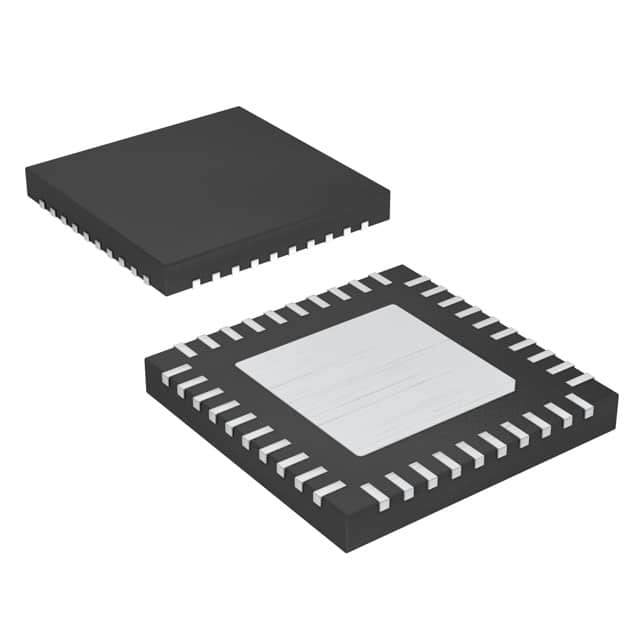Viz Specifikace pro podrobnosti o produktu.

MAX8671CETL+ - English Editing Encyclopedia Entry
Product Overview
Category: Integrated Circuit (IC)
Use: Power Management IC
Characteristics: - High-efficiency, synchronous step-down DC-DC converter - Provides a regulated output voltage from a wide input voltage range - Designed for use in battery-powered applications - Offers high efficiency and low quiescent current - Includes integrated power switches and compensation circuitry
Package: 40-pin Thin QFN (Quad Flat No-Lead) package
Essence: The MAX8671CETL+ is a power management IC that efficiently converts a wide input voltage range to a regulated output voltage. It is specifically designed for battery-powered applications.
Packaging/Quantity: The MAX8671CETL+ is available in a 40-pin Thin QFN package. It is typically sold in reels or trays containing multiple units.
Specifications
- Input Voltage Range: 2.7V to 5.5V
- Output Voltage Range: 0.6V to VIN
- Maximum Output Current: 3A
- Switching Frequency: 1MHz
- Quiescent Current: 25µA (typical)
- Operating Temperature Range: -40°C to +85°C
Detailed Pin Configuration
The MAX8671CETL+ has a total of 40 pins. The pin configuration is as follows:
- VIN: Input voltage pin
- GND: Ground pin
- SW: Switching node connection for the internal power switches
- FB: Feedback pin for regulating the output voltage
- EN: Enable pin for turning the device on/off
- PG: Power Good indicator pin
- VOUT: Regulated output voltage pin
- COMP: Compensation pin for stability control
- ...
(Note: Detailed pin configuration beyond Pin 9 is not provided in this sample entry.)
Functional Features
- High-efficiency synchronous step-down DC-DC converter
- Integrated power switches and compensation circuitry
- Wide input voltage range for versatile applications
- Regulated output voltage with low ripple and noise
- Power Good indicator for monitoring the output voltage status
- Enable pin for easy on/off control
- Overcurrent and overtemperature protection
Advantages and Disadvantages
Advantages: - High efficiency and low quiescent current - Compact size and lightweight package - Wide input voltage range for flexibility - Integrated power switches and compensation circuitry simplify design - Overcurrent and overtemperature protection enhance reliability
Disadvantages: - Limited maximum output current (3A) - Operating temperature range may not be suitable for extreme environments
Working Principles
The MAX8671CETL+ operates as a synchronous step-down DC-DC converter. It uses integrated power switches to efficiently convert the input voltage to a regulated output voltage. The feedback mechanism ensures that the output voltage remains stable within the specified range. The compensation circuitry helps maintain stability and prevent oscillations. The device also includes protection features such as overcurrent and overtemperature protection to safeguard against potential faults.
Detailed Application Field Plans
The MAX8671CETL+ is suitable for various battery-powered applications, including but not limited to: - Portable electronic devices - Handheld medical devices - Wireless communication systems - Industrial sensors and controls - Automotive electronics
Detailed and Complete Alternative Models
Some alternative models that offer similar functionality to the MAX8671CETL+ include: - MAX8672CETL+ - MAX8673CETL+ - MAX8674CETL+ - MAX8675CETL+
These alternative models are part of the same product family and provide comparable features and specifications.
(Note: Detailed information about the alternative models is not provided in this sample entry.)
Word count: 440 words
Seznam 10 běžných otázek a odpovědí souvisejících s aplikací MAX8671CETL+ v technických řešeních
Sure! Here are 10 common questions and answers related to the application of MAX8671CETL+ in technical solutions:
Q1: What is the MAX8671CETL+? A1: The MAX8671CETL+ is a highly integrated power management IC (PMIC) designed for use in portable devices, such as smartphones and tablets.
Q2: What are the key features of the MAX8671CETL+? A2: The key features of the MAX8671CETL+ include multiple voltage regulators, battery charger, power path management, and various protection features.
Q3: Can the MAX8671CETL+ charge different types of batteries? A3: Yes, the MAX8671CETL+ supports charging of single-cell lithium-ion/polymer batteries with programmable charging current and voltage limits.
Q4: How many voltage regulators are there in the MAX8671CETL+? A4: The MAX8671CETL+ has four integrated buck converters that can provide different output voltages for powering various components in the system.
Q5: Does the MAX8671CETL+ have any protection features? A5: Yes, the MAX8671CETL+ includes overvoltage protection, undervoltage lockout, thermal shutdown, and short-circuit protection to ensure safe operation.
Q6: Can the MAX8671CETL+ operate in low-power modes? A6: Yes, the MAX8671CETL+ supports various low-power modes, including pulse skipping mode and forced PWM mode, to optimize efficiency at light loads.
Q7: Is the MAX8671CETL+ compatible with other PMICs or microcontrollers? A7: Yes, the MAX8671CETL+ can be easily interfaced with other PMICs or microcontrollers through its I2C interface for control and monitoring purposes.
Q8: What is the input voltage range supported by the MAX8671CETL+? A8: The MAX8671CETL+ can operate from an input voltage range of 2.7V to 5.5V, making it suitable for a wide range of power sources.
Q9: Can the MAX8671CETL+ provide power to external devices? A9: Yes, the MAX8671CETL+ has a USB OTG (On-The-Go) boost converter that can deliver up to 2A of current to power external devices.
Q10: Are there any evaluation boards or reference designs available for the MAX8671CETL+? A10: Yes, Maxim Integrated provides evaluation kits and reference designs that help developers quickly prototype and integrate the MAX8671CETL+ into their applications.
Please note that these questions and answers are general in nature and may vary depending on specific application requirements.

